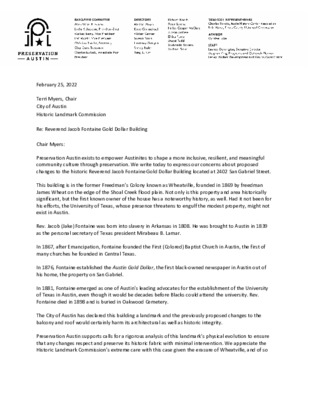B.1.c - 2402 San Gabriel St - public comment — original pdf
Backup

February 25, 2022 Terri Myers, Chair City of Austin Historic Landmark Commission Re: Reverend Jacob Fontaine Gold Dollar Building Chair Myers: Preservation Austin exists to empower Austinites to shape a more inclusive, resilient, and meaningful community culture through preservation. We write today to express our concerns about proposed changes to the historic Reverend Jacob Fontaine Gold Dollar Building located at 2402 San Gabriel Street. This building is in the former Freedman’s Colony known as Wheatville, founded in 1869 by freedman James Wheat on the edge of the Shoal Creek flood plain. Not only is this property and area historically significant, but the first known owner of the house has a noteworthy history, as well. Had it not been for his efforts, the University of Texas, whose presence threatens to engulf the modest property, might not exist in Austin. Rev. Jacob (Jake) Fontaine was born into slavery in Arkansas in 1808. He was brought to Austin in 1839 as the personal secretary of Texas president Mirabeau B. Lamar. In 1867, after Emancipation, Fontaine founded the First (Colored) Baptist Church in Austin, the first of many churches he founded in Central Texas. In 1876, Fontaine established the Austin Gold Dollar, the first black-owned newspaper in Austin out of his home, the property on San Gabriel. In 1881, Fontaine emerged as one of Austin's leading advocates for the establishment of the University of Texas in Austin, even though it would be decades before Blacks could attend the university. Rev. Fontaine died in 1898 and is buried in Oakwood Cemetery. The City of Austin has declared this building a landmark and the previously proposed changes to the balcony and roof would certainly harm its architectural as well as historic integrity. Preservation Austin supports calls for a rigorous analysis of this landmark’s physical evolution to ensure that any changes respect and preserve its historic fabric with minimal intervention. We appreciate the Historic Landmark Commission’s extreme care with this case given the erasure of Wheatville, and of so many other Black settlements in West and South Austin, as well as continued threats to African American heritage throughout the city. Also, if possible, we would encourage outreach to any of Rev. Fontaine’s descendants who may still live in the area who may not be aware of these proposed changes. And, given the controversial issues related to erasure of African American places and spaces, perhaps this could provide a path to a broader discussion about historic preservation in Austin. Thank you for your service, and for your consideration. Sincerely, Lindsey Derrington Executive Director